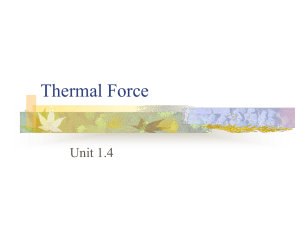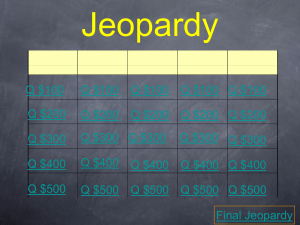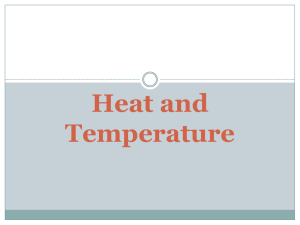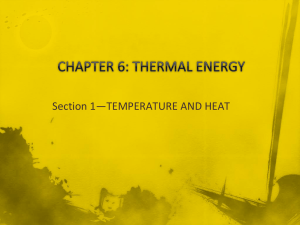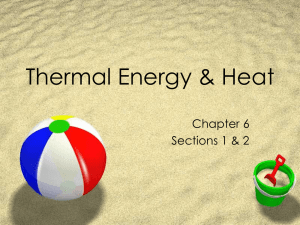Heat
advertisement
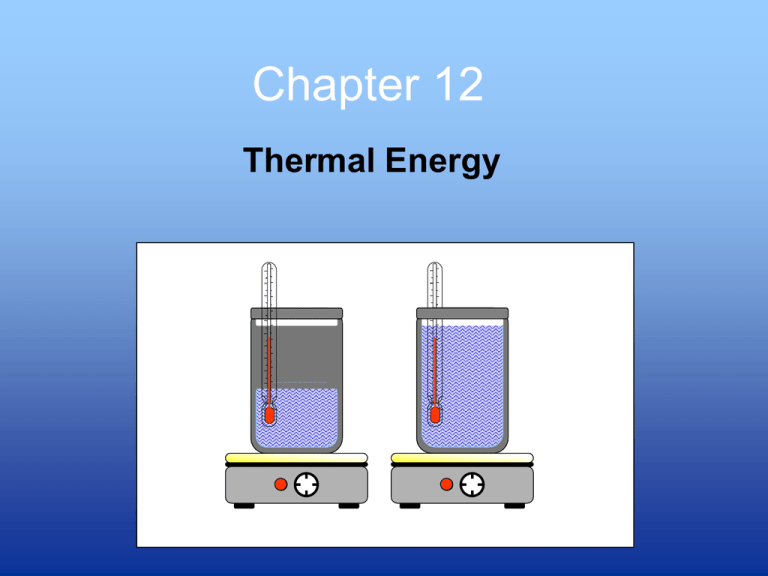
Chapter 12 Thermal Energy Heat and Temperature Light Law of Conservation of Energy? When rub your hands together • What is the Net KE? – Zero, the motion is in opposite directions. • What is the change is PE? – Zero, your hands are at the same height. • You did work against friction, where did the energy go? • You did work against friction, where did the energy go? Thermal Energy • Thermal Energy: The total internal Energy • Internal Energy: The sum of the kinetic and potential energies of the internal motion of particles that make up an object. Kinetic-molecular Theory • All matter is made up of molecules and atoms • Molecules are in constant motion • Objects in motion have Kinetic Energy. Kinetic-molecular Theory • Molecules are in constant motion • Objects in motion have Kinetic Energy. • When particles get hotter, they move faster (e.g. higher Kinetic Energy) Heat Heat Applet The Nature of Matter • Molecules in liquids and gases move freely. • Molecules in solids simply vibrate. • This means that all molecules possess their own kinetic energy (KE), the energy of motion. Solid Liquid/Gas Temperature • Molecules move at different speeds. • Now let’s add some heat? – Now they are all moving faster! • Temperature relates to the average kinetic energy of the molecules in a substance. The higher the temperature, the faster the molecules move. Temperature Scales • Celsius – Water boils at – Water at Freezes 100oC 0oC C F 100 212 • Fahrenheit – Water boils at – Water Freezes at 212oF 32oF 0 • Kelvin – Absolute Zero – Water boils at – Water Freezes at -40 0ºK 373oK 273oK 32 -40 Temperature Scales conversions Fahrenheit Celsius Range 180 18 9 10 5 Range 100 Fahrenheit scale freezes 32o above Celsius 9 TF TC 32 5 Temperature Scales conversions Celsius Range 100 Fahrenheit 10 5 Range 180 18 9 Celsius scale freezes 32o below Fahrenheit 5 TC TF 32 9 Temperature Scales • There are three major temperature scales that we will deal with. – The Fahrenheit Scale (°F) – The Celsius Scale (°C) – The Kelvin Scale (°K) • Conversion formulas are shown below. TF 95 TC 32 TC 95 TF 32 TK TC 273.15 TC TK 273.15 Sample Temperature Conversion • A beaker of water at room temperature is measured to be at 21°C. • What is the Fahrenheit and Kelvin temperature? TF 95 TC 32 TK TC 273.15 TF 95 21 32 TK 21 273.15 TK 294.15K TF 69.8F Temperature Scales conversions Example 1 • Convert 45ºF to Celsius 5 TC TF 32 9 5 TC 45o 32 9 5 TC 13 9 TC 7.2o C Temperature Scales conversions Example 1 • Convert 32ºC to Fahrenheit 9 TF TC 32 5 9 TF (32) 32 5 TF 57.6 32 TF 89.6 Homework • WS1 1-5 • WS 1a 1-3 Absolute Zero • The final temperature to note is absolute zero, 0K. • This is the lowest possible temperature. • Here molecules are in a complete state of rest, which means that there is no kinetic energy. • Absolute zero has never been reached. • However, scientists have come within 0.1K • Pressure versus Temp graphs 0K Thermal Contact • KE transfer through thermal contact COLD WARM KE KE Warm KE KE HOT Thermal Equilibrium: – Both objects have the same average Kinetic Energy What is Heat? • Heat is energy in transfer from an object of higher temperature to one of lower temperature. • The quantity of energy transfer from one object to another because of a difference in temperature. Heat Flow Cold Warm Warm Hot Thermal Energy • The sum of all the kinetic energies within a material is known as thermal energy. • Both full cups of coffee are at the same temperature. – Which cup contains greater thermal energy? B – Which cup contains a higher average kinetic energy within the molecules? Both are the same! A B Heat & Kinetic Energy • Both Brass blocks are at 115oC. Brass Brass • Which block has the higher KE? • Which block has the higher average KE? Homework • WS #1 4-9 • WS #1 4-13 Specific Heat Video Clip Specific Heat Heat: The energy that flows as a result of a difference in temperature Q: The symbol for heat. Measured in Joules Specific Heat (C): The amount of energy needed to raise a unit of mass one temperature unit. (J/kg K) Heat gained Q mCT Q: Heat m: mass ΔT: Change in Temperature Sample Heat Problem • How much heat is required to raise the temperature of a 2.4kg gold ingot (c = 129J/kgK) from 23°C to 45°C? T TF TI T 45C 23C T 22C Q mcT J Q 2.4kg 129 kgK Q 6811.2 J Light 2.4kg 22C Heat Transfer Example 1 A 0.40kg block of iron is heated from 295K to 325K. How much heat is absorbed by the iron? C 450 KgJ K Q mCT Q (.4kg)(450 KgJ K )(325K 295K ) Q 5400 J Heat Transfer WS3 #1 How much heat is absorbed by 60.0g of copper when it is heated from 20ºC to 80ºC 60 g .06kg C 385 KgJ K 80o C 353K Q mCT Q (.06kg )(385 KhJ K )(353K 293K ) Q 1386 J Practice Problems • WS 3a – #’s 1-3 Specific heat Calorimerty Calorimeter: A device used to measure changes in thermal energy. Calorimerty Utilizes on the conservation of energy. Qgained + Qlost = Zero Calorimerty Example A .4kg block of zinc @115°C is placed in .5kg of water @15°C. Find the final temperature. C 388 kgJ K Qgained Qlost 0 maCa Ta mbCb Tb 0 maCa (Tf Tai ) mbCb (Tf Tbi ) 0 J J .4kg(388 kgK )(t f 115 oC) .5kg(4180 kgK )(t f 15 oC) 0 Tf 21.9 C o Calorimerty Example A .1kg block of brass @90°C is placed in .2kg of water @20°C. Find the final temperature. maCa Ta mbCb Tb 0 .1kg (376 kg Jo C )(t f 90 oC ) .2kg (4180 kg JoC )(t f 20 oC ) 0 Tf 23.0o C Practice Problems • Book Page 252 – #’s 9-11Calorimetery • WS4 – # 7-11 Calorimetery WS #3 – Problem # 1 a-d – Problem #2 a-d • Quiz Latent Heat (Enthalpy) • Describe what Q=mCΔT means • Is it possible to add heat without changing the temperature? • A heat transfer is also required to change phase. • Heat must be added to go to a more energetic phase. • Heat must be removed to go to a less energetic phase. +Q Solid +Q Vapo r Liquid -Q -Q Substances in Phase Transfer C F 100 212 0 40 32 40 Heats of Fusion and Vaporization • Heat of fusion (Hf): the amount of heat energy required change 1kg of substance in the solid state into the liquid state. • The equation is as follows: Q mLf • The heat of vaporization (Hv) is the amount of heat energy required to change 1kg of substance in the liquid state into the vapor state. • The equation is as follows: Q mLv Sample Heating Across Phase • A block of ice (m = 1.2kg) at -10°C being heated to water at 80°C. How much heat is used? 3 Steps Heating Ice -10°C Ice 0°C Q mcT Q mcT mLf mcT Melting Q mH f Water 0°C Q 1.2kg 2060 kgJC 10C 1.2kg 3.34 105 J kg Heating Q mcT Water 80°C 1.2kg 4180 Q 826800 J • These problems have 1-5 steps. J kg C 80C The Heating Curve (H2O) • As H2O is heated from ice below freezing to steam above boiling, the temperature can be plotted with respect to time. • Where are the flat spots located? Temperature remains constant during phase changes. Heating Curve of Water Boiling Heating Melting Heat Heat 140 Once each phase change is complete, temperature can rise again. Temperature (C) 120 100 80 60 40 20 0 -20 0 5 10 Time (min) 15 20 The Cooling Curve (H2O) • The cooling curve is very similar to the heating curve • What can you conclude about temperatures when cooling between phases? The temperature can continue to drop after all of the substance is converted into the next phase. Cooling Curve of Water Condensing Solidifying Cooling Cool 140 120 Temperature (C) Cooling also requires the temperature to be held constant while in the midst of a phase change. 100 80 60 40 20 0 -20 0 5 10 Time (min) 15 20 Phase Change WS7 #1 • • • • Between A-B: The ice is warming to 0oC Between B-C: Thermal energy melts the ice at 0oC Between C-D: The water is warm to 100oC Between D-E: The water boils and changes to vapor at 100oC • After E: The temperature of the vapor increases Latent Heat Temperature (C) 150 D 100 C 50 B 0 -50 A Time E Practice Problems • WS #7 – # 1 b-g – # 2,3 Heat of fusion WS8 #1 If 5,000J is added to ice at 0oC, how much ice is melted? Q=mLf Water Water Q=mLv Hf=3.34x105J/kg Hv=2.26x106J/kg m Q / Lf m 5000J / 3.34 x105 J / kg m .015kg Heat of fusion WS8 #2 How much heat must be transferred to 100g of ice at 00C until the ice melts and the temperature of the resulting water rises to 200C? Water Hf=3.34x105J/kg Qmelt ice mH f Q .1kg (3.34x105 kgJ ) Q 3.34x10 J 4 Qheat water mCT Q .1kg (4180 Q 8360 J Qtotal 3.34 x104 J 8360 J Qtotal 41760 J J kg 0 C 0 )20 C Homework WS #8 – #’s 3-5 • Book Page 255 – # 16 Heat of fusion • WS #7 (5 heats) Thermal Energy Transfer • Conduction: – Transfer of Kinetic Energy by contact • Convection: – Heat transfer by the motion of a fluid (e.g. air) • Radiation: – Electromagnetic waves carry energy Note: Conduction and Convection require matter Thermal Energy Transfer video Clip Conduction • Conduction is the transfer of heat through molecular collisions. • This form of heat transfer best occurs in solids where molecules are closely packed. • Materials that conduct heat well are called conductors. (Eg. metals such as copper and iron) • Materials that conduct heat poorly are called insulators. (Eg. foam, air, and asbestos) Magnification Convection • Convection is the transfer of heat though moving fluids. • A fluid is any substance that flows, which includes all liquids and gases. • Examples include convection ovens and cloud formation. Convection ? The Heating Water Pot • Have you ever watched a pot of water when it is being heated, especially while boiling? What do you notice? • You will notice that there are currents within the pot. The process of convection transfers heated water from the bottom of the pot to the top, where it is exchanged for cooler water. Convection • Gulf stream current • http://rads.tudelft.nl/gulfstream/#fig2 Convection It was remarkable how weightlessness affected things: I found that if I stayed perfectly still, my own body heat built up around me like a tenuous blanket, because there was no convection to carry it away. But my slightest motion dispelled this warmth and let me cool. – Jim Lovell, Apollo 13 Radiation (not radioactivity) • • • • Radiation is the transfer of heat via electromagnetic waves. These waves include visible light, but are mostly infrared. No matter is required for this type of heat transfer. Examples include the sun’s heat and warmth felt from a flame. Open Space Radiation ? More on Radiation • All objects emit heat in the form of radiation (radiant heat). • Hotter objects emit more energetic waves. • Some extremely hot objects can emit visible light, a form of electromagnetic radiation. • In fact, all forms of radiation travel at the speed of light. 2.998 10 8 m s Objects in thermal equilibrium will emit the same amount of radiation that they receive from other objects. Heat Transfer Question • Consider a camp fire burning vigorously. – How is heat normally transferred while warming its viewers? • Radiation – How is heat transferred when you put a hand in the smoke? • Convection – How is heat transferred to a stick when it is placed in the hot coals? • Conduction • Some situations involve multiple heat transfer types like this. Homework • WS #4 1-6 – Thermal Energy Transfer Homework • WS #2 – Temperature Conversions Thermal Expansion • The change in length of a material due to change in temperature. Thermal Expansion Video Clip • Expansion and Contraction movie clip. Linear Expansion • Most objects expand when heated and contract when cooled • The change in length of a solid is proportional to ΔT • The change in length is proportional to the length of the object L Li Li (T Ti ) Linear Expansion animation • Expansion Joint Linear Expansion animation • Expansion joint versus NO joint Linear Expansion animation • Expansion in a U joint Linear Expansion animation • Expansion in an elbow joint Linear Expansion WS9 #1 A metal bar is 2.6m long at 210C. The bar is heat to 930C and the length increases by 3.4mm. What is the coefficient of linear expansion? Li 2.6m Ti 210 C T 930 C L 3.4 x103 m L Li Li (T Ti ) L Li (T Ti ) L 3.4 x103 m Li T 2.6m(720 C ) Heat 1.8x10 ( C) 5 0 1 Sample Linear Expansion Problem • A train rail is initially 20m long in the morning when the temperature outside is 10°C. By how much will the rail expand in the heat of the day when the temperature reaches 35°C? • The coefficient of linear expansion for steel is: 8.0 106 C 1 • Now find L. L LiT L 20m 8.0 106 35C 10C L 0.004m L L f Li • What is the final length? L f Li L Lf 20m 0.004m 20.004m Linear Expansion WS9 #2 • A piece of aluminum siding 3.66m long on a 28.00C winter day is how long on a hot 390C summer day? 25 x10 6 0 C 1 L Li Li (T Ti ) 6 0 L 3.66m (25x10 1 C )(3.66m)(39 C 28 C) L 3.666m 0 0 Practice Problems • WS 9 – #’s 3-5 Linear Expansion The Bimetallic Strip • A bimetallic strip consists of two metal strips pressed together into a single strip. • A common strip consists of steel and brass. • Since different materials expand at different rates, the strip will bend. Room Temp Steel Brass High Temp Steel Brass Low Temp Steel Brass The Bimetallic Strip (Cont.) • Bimetallic strips are most often used in temperature sensitive instruments as thermostats. • The strip is wound into a coil. • As temperature changes, the coil expands or contracts to activate a switch controlling a heating/cooling system. I’m Cold!! Hot!!! Heat AC Expansion of Water • • • • • Water initially at 100C that cools to 40C Water initially at 40C that cools to 00C Water initially at 00C that freezes to 00C ice Water initially at 100C that cools to 40C Water initially at 100C that cools to 40C Unique Properties of Water (Cont.) • In liquid water, the molecules move freely in no particular order or array. This is what allows them to flow. • When water freezes, the molecules form a hexagonal pattern. • Why may ice possess less density? Solid Ice Liquid Water O H O H H O H H H O H H O O O H H H H O H H H H Open Space O H H Applications of Linear Expansion • Linear expansion must be taken into consideration for engineers designing something that will experience a range of temperatures. • Here are just a few select examples: Railroads Bridges Metal Roofs Practice Problems • WS #5 1-16 Thermal Expansion End Unit on Heat Latent Heat Temperature (C) 150 100 50 0 -50 Time C F 100 212 0 40 32 40 Change of State • States of mater – Solid – Liquid – Gas examples • Examples – Temperature scales • Examples – Convert Celsius to Fahrenheit – Convert Fahrenheit to Celsius • • • • Heat transfer types Calorimeter and specific heat Thermal expansion Examples – Conservation of energy transfer C F 100 212 0 40 32 40 Thermal Energy COLD HOT

